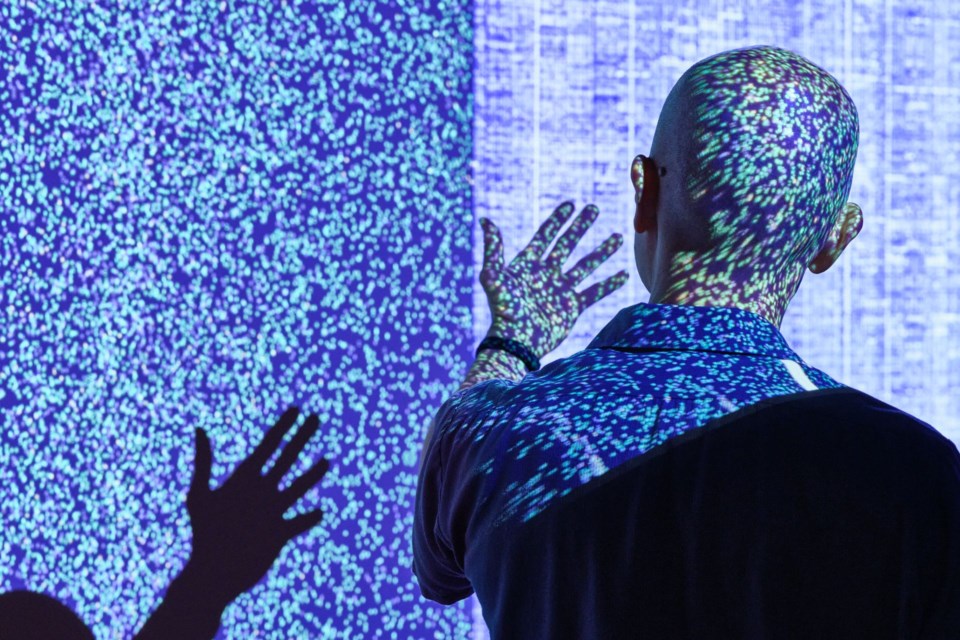The ongoing art show Indivisible at New Media Gallery includes exhibits that teeter between art and science. One of them is a detector that lights up every time it comes in contact with muons — the only particles from space that make it to the earth, as per the exhibit description.
Also part of the show are a fluxgate magnetometer, which registers the earth’s magnetic field and projects it like an animated pen and ink painting on the wall; a video installation of matter and antimatter colliding that looks like a Jackson Pollock painting in black and white, and more.
So is it science or art?
“It's art that's working with science,” said Laura Marks, a philosopher and scholar of new media and film, and a Grant Strate Professor at Simon Fraser University, noting the show features art that relies on pure scientific data.
When Monika Stachura, research scientist at TRIUMF, Canada's particle accelerator centre, and adjunct professor at Simon Fraser University, first saw the exhibition, she felt that she was seeing a display of "science" instead of art.
“But then I had this phenomenal discussion with Sarah [Joyce, director-curator at New Media Gallery], and she walked me through the artistic side of it. And that dialogue was so incredibly important because it made me understand where she's coming from. And, suddenly, I started seeing those pieces from a different perspective.”
Both Marks and Stachura talked about how they perceived the art exhibition at the Indivisible: Imagination Dialogue talk, moderated by Sharad Kharé, founder of Human Biography, who has documented renowned personalities such as the Dalai Lama and Meryl Streep, among others.
Can art and science coexist?
“People tend to think about physicists, and scientists in general, as people who are extremely logical, extremely rational.”
That is not quite true; scientists and artists have more in common than what is commonly thought, as per Stachura.
When it comes to creating something, “I think they [scientists and artists] start with a very similar feeling. In a way they start with curiosity and wonder — you wonder how the universe works, you wonder about life, about the nature of why things happen a certain way. And the way you express what you're working on, can take a different path. It can be artistic, but it can also be more fundamental — this is what we do in science.”
But scientists often struggle with relating to the general public. Which is why she considers the work of artists at this particular show “phenomenal," because they have cracked a way to draw the audience to science.
There is a common belief that art and science cannot be together, but “this exhibition is the opposite of that," she said.
“It [the exhibition] shows how the two of them [art and science], even though they seem to be going in two different highways, are going in the same direction; they have the same goal, they are actually trying to appeal to the same crowd.”
Art helps sense things that are invisible
What makes the works relatable to a crowd with no knowledge of physics is that they are visually striking, appeal to the senses, and, as Marks said, "invite empathy" — even with subatomic particles and wavelengths that you otherwise can't see.
They let us imagine ourselves to be in the position of that matter that collides with an antimatter, or that cosmic particle that's found its way to the earth from space, she added.
And, since it is all science based, the artworks also give a sense of confidence that "what I'm seeing, and in one case, hearing, is a direct translation of something that's happening either at the level of vibration that I cannot sense in my body, or at a scale of particle activity that I cannot perceive."
"I feel such gratefulness because the artwork makes them present for me ... you know, I'm present with with those electromagnetic frequencies or with those muons visiting the earth."
The show Indivisible, organized in partnership with Swiss consulate in Vancouver and Arts at Cern, is on till Aug. 14 at the New Media Gallery, 777 Columbia St.




